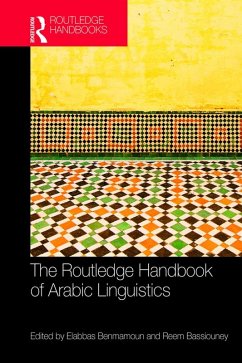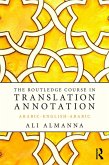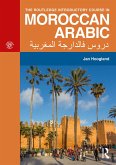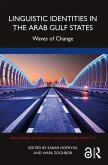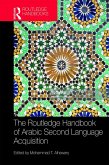The Routledge Handbook of Arabic Linguistics (eBook, PDF)
Redaktion: Benmamoun, Elabbas; Bassiouney, Reem
48,95 €
48,95 €
inkl. MwSt.
Sofort per Download lieferbar

24 °P sammeln
48,95 €
Als Download kaufen

48,95 €
inkl. MwSt.
Sofort per Download lieferbar

24 °P sammeln
Jetzt verschenken
Alle Infos zum eBook verschenken
48,95 €
inkl. MwSt.
Sofort per Download lieferbar
Alle Infos zum eBook verschenken

24 °P sammeln
The Routledge Handbook of Arabic Linguistics (eBook, PDF)
Redaktion: Benmamoun, Elabbas; Bassiouney, Reem
- Format: PDF
- Merkliste
- Auf die Merkliste
- Bewerten Bewerten
- Teilen
- Produkt teilen
- Produkterinnerung
- Produkterinnerung

Bitte loggen Sie sich zunächst in Ihr Kundenkonto ein oder registrieren Sie sich bei
bücher.de, um das eBook-Abo tolino select nutzen zu können.
Hier können Sie sich einloggen
Hier können Sie sich einloggen
Sie sind bereits eingeloggt. Klicken Sie auf 2. tolino select Abo, um fortzufahren.

Bitte loggen Sie sich zunächst in Ihr Kundenkonto ein oder registrieren Sie sich bei bücher.de, um das eBook-Abo tolino select nutzen zu können.
The Routledge Handbook of Arabic Linguistics is a much needed resource for researchers on Arabic and comparative linguistics, syntax, morphology, computational linguistics, psycholinguistics and applied linguistics, and also to undergraduate and graduate students studying Arabic or Linguistics.
- Geräte: PC
- mit Kopierschutz
- eBook Hilfe
- Größe: 4.61MB
Andere Kunden interessierten sich auch für
![The Routledge Handbook of Arabic Translation (eBook, PDF) The Routledge Handbook of Arabic Translation (eBook, PDF)]() The Routledge Handbook of Arabic Translation (eBook, PDF)45,95 €
The Routledge Handbook of Arabic Translation (eBook, PDF)45,95 €![The Routledge Course in Translation Annotation (eBook, PDF) The Routledge Course in Translation Annotation (eBook, PDF)]() Ali AlmannaThe Routledge Course in Translation Annotation (eBook, PDF)47,95 €
Ali AlmannaThe Routledge Course in Translation Annotation (eBook, PDF)47,95 €![The Routledge Introductory Course in Moroccan Arabic (eBook, PDF) The Routledge Introductory Course in Moroccan Arabic (eBook, PDF)]() Jan HooglandThe Routledge Introductory Course in Moroccan Arabic (eBook, PDF)49,95 €
Jan HooglandThe Routledge Introductory Course in Moroccan Arabic (eBook, PDF)49,95 €![The Routledge Course in Arabic Business Translation (eBook, PDF) The Routledge Course in Arabic Business Translation (eBook, PDF)]() Mahmoud AltarabinThe Routledge Course in Arabic Business Translation (eBook, PDF)37,95 €
Mahmoud AltarabinThe Routledge Course in Arabic Business Translation (eBook, PDF)37,95 €![The Routledge Handbook of Arabic and Identity (eBook, PDF) The Routledge Handbook of Arabic and Identity (eBook, PDF)]() The Routledge Handbook of Arabic and Identity (eBook, PDF)48,95 €
The Routledge Handbook of Arabic and Identity (eBook, PDF)48,95 €![Linguistic Identities in the Arab Gulf States (eBook, PDF) Linguistic Identities in the Arab Gulf States (eBook, PDF)]() Linguistic Identities in the Arab Gulf States (eBook, PDF)38,95 €
Linguistic Identities in the Arab Gulf States (eBook, PDF)38,95 €![Routledge Handbook of Arabic Second Language Acquisition (eBook, PDF) Routledge Handbook of Arabic Second Language Acquisition (eBook, PDF)]() Routledge Handbook of Arabic Second Language Acquisition (eBook, PDF)48,95 €
Routledge Handbook of Arabic Second Language Acquisition (eBook, PDF)48,95 €-
-
-
The Routledge Handbook of Arabic Linguistics is a much needed resource for researchers on Arabic and comparative linguistics, syntax, morphology, computational linguistics, psycholinguistics and applied linguistics, and also to undergraduate and graduate students studying Arabic or Linguistics.
Dieser Download kann aus rechtlichen Gründen nur mit Rechnungsadresse in A, B, BG, CY, CZ, D, DK, EW, E, FIN, F, GR, HR, H, IRL, I, LT, L, LR, M, NL, PL, P, R, S, SLO, SK ausgeliefert werden.
Produktdetails
- Produktdetails
- Verlag: Taylor & Francis eBooks
- Seitenzahl: 598
- Erscheinungstermin: 22. Dezember 2017
- Englisch
- ISBN-13: 9781351377805
- Artikelnr.: 50531402
- Verlag: Taylor & Francis eBooks
- Seitenzahl: 598
- Erscheinungstermin: 22. Dezember 2017
- Englisch
- ISBN-13: 9781351377805
- Artikelnr.: 50531402
- Herstellerkennzeichnung Die Herstellerinformationen sind derzeit nicht verfügbar.
Elabbas Benmamoun is Professor of Asian and Middle Eastern Studies and Linguistics at Duke University, USA. Reem Bassiouney is Professor in the Applied Linguistics Department at the American University in Cairo, Egypt.
Introduction. I. Phonetics
Phonology
and Morphology: 1. Arabic Phonology
2. Syllable Structure in the Dialects of Arabic
3. Pharyngeal and Emphatic Consonants
4. Stems in Arabic Morphology and Phonology
II. Syntax
Semantics
and Pragmatics 1. The Syntax of Tense in Arabic
2. Negative Sensitive Items
3. Resumption
4. Personal Datives in Lebanese Arabic
5. Arabic Semantics
6. Arabic Functional Linguistics
III. Experimental and Computational Approaches 1. First Language Acquisition of Arabic
2. Neurophysiological investigations in studies of Arabic linguistics: The case of Arabic diglossia
3. Arabic Heritage Speakers in the US
4. Experimental Data and Arabic Morphology
5. Arabic Speech and Language Technology
IV. History
Contact
and Variation 1. Arabic and the other Semitic Languages
2. Diglossia
3. An Alternative Approach: Understanding Diglossia/Code-switching Through Indexicality: The Case of Egypt
4. Patterns of Variation and Change in the Arab World
5. Social Status
Language and Society in the Arab World
6. New Elaborate Written Forms in Darija: Blogging
Posting and Slamming in 2015 Morocco
7. Arabic as a Contact Language
8. Contemporary Arabic-based Pidgins in the Middle East
9. Linguistic Anthropology Approaches to Arabic
10. Peripheral Arabic
V. Ideology
Policy
and Education 1. Arab Nationalism and/as Language Ideology
2. Waves of Arabization and the Vernaculars of North Africa
3. The Arabic Language and Political Ideology
4.
Phonology
and Morphology: 1. Arabic Phonology
2. Syllable Structure in the Dialects of Arabic
3. Pharyngeal and Emphatic Consonants
4. Stems in Arabic Morphology and Phonology
II. Syntax
Semantics
and Pragmatics 1. The Syntax of Tense in Arabic
2. Negative Sensitive Items
3. Resumption
4. Personal Datives in Lebanese Arabic
5. Arabic Semantics
6. Arabic Functional Linguistics
III. Experimental and Computational Approaches 1. First Language Acquisition of Arabic
2. Neurophysiological investigations in studies of Arabic linguistics: The case of Arabic diglossia
3. Arabic Heritage Speakers in the US
4. Experimental Data and Arabic Morphology
5. Arabic Speech and Language Technology
IV. History
Contact
and Variation 1. Arabic and the other Semitic Languages
2. Diglossia
3. An Alternative Approach: Understanding Diglossia/Code-switching Through Indexicality: The Case of Egypt
4. Patterns of Variation and Change in the Arab World
5. Social Status
Language and Society in the Arab World
6. New Elaborate Written Forms in Darija: Blogging
Posting and Slamming in 2015 Morocco
7. Arabic as a Contact Language
8. Contemporary Arabic-based Pidgins in the Middle East
9. Linguistic Anthropology Approaches to Arabic
10. Peripheral Arabic
V. Ideology
Policy
and Education 1. Arab Nationalism and/as Language Ideology
2. Waves of Arabization and the Vernaculars of North Africa
3. The Arabic Language and Political Ideology
4.
Introduction. I. Phonetics
Phonology
and Morphology: 1. Arabic Phonology
2. Syllable Structure in the Dialects of Arabic
3. Pharyngeal and Emphatic Consonants
4. Stems in Arabic Morphology and Phonology
II. Syntax
Semantics
and Pragmatics 1. The Syntax of Tense in Arabic
2. Negative Sensitive Items
3. Resumption
4. Personal Datives in Lebanese Arabic
5. Arabic Semantics
6. Arabic Functional Linguistics
III. Experimental and Computational Approaches 1. First Language Acquisition of Arabic
2. Neurophysiological investigations in studies of Arabic linguistics: The case of Arabic diglossia
3. Arabic Heritage Speakers in the US
4. Experimental Data and Arabic Morphology
5. Arabic Speech and Language Technology
IV. History
Contact
and Variation 1. Arabic and the other Semitic Languages
2. Diglossia
3. An Alternative Approach: Understanding Diglossia/Code-switching Through Indexicality: The Case of Egypt
4. Patterns of Variation and Change in the Arab World
5. Social Status
Language and Society in the Arab World
6. New Elaborate Written Forms in Darija: Blogging
Posting and Slamming in 2015 Morocco
7. Arabic as a Contact Language
8. Contemporary Arabic-based Pidgins in the Middle East
9. Linguistic Anthropology Approaches to Arabic
10. Peripheral Arabic
V. Ideology
Policy
and Education 1. Arab Nationalism and/as Language Ideology
2. Waves of Arabization and the Vernaculars of North Africa
3. The Arabic Language and Political Ideology
4.
Phonology
and Morphology: 1. Arabic Phonology
2. Syllable Structure in the Dialects of Arabic
3. Pharyngeal and Emphatic Consonants
4. Stems in Arabic Morphology and Phonology
II. Syntax
Semantics
and Pragmatics 1. The Syntax of Tense in Arabic
2. Negative Sensitive Items
3. Resumption
4. Personal Datives in Lebanese Arabic
5. Arabic Semantics
6. Arabic Functional Linguistics
III. Experimental and Computational Approaches 1. First Language Acquisition of Arabic
2. Neurophysiological investigations in studies of Arabic linguistics: The case of Arabic diglossia
3. Arabic Heritage Speakers in the US
4. Experimental Data and Arabic Morphology
5. Arabic Speech and Language Technology
IV. History
Contact
and Variation 1. Arabic and the other Semitic Languages
2. Diglossia
3. An Alternative Approach: Understanding Diglossia/Code-switching Through Indexicality: The Case of Egypt
4. Patterns of Variation and Change in the Arab World
5. Social Status
Language and Society in the Arab World
6. New Elaborate Written Forms in Darija: Blogging
Posting and Slamming in 2015 Morocco
7. Arabic as a Contact Language
8. Contemporary Arabic-based Pidgins in the Middle East
9. Linguistic Anthropology Approaches to Arabic
10. Peripheral Arabic
V. Ideology
Policy
and Education 1. Arab Nationalism and/as Language Ideology
2. Waves of Arabization and the Vernaculars of North Africa
3. The Arabic Language and Political Ideology
4.
